To Issue 168
Citation: Chu L, “Versatility, Sustainability and Digitalisation in One Smart Handheld Injection Platform”. ONdrugDelivery, Issue 168 (Jan 2025), pp 60–64.
Leonard Chu discusses three trends in self-administration that are aligned with emerging smart devices – device versatility, sustainability and digitalisation – and the benefits offered by Altek Medical‘s Alcee injection platform.
The public health crisis of covid-19 and the surging popularity of glucagon-like peptide-1 (GLP-1) injection for weight loss have inspired some thoughts on the potential of using smart injection devices. For example, smart devices could be the key enabling tools when the segregation of a population is required to control the spread of a disease. Collecting data from multi-variable dosing or high-frequency dosing could be useful for tracking treatment and evaluating the clinical outcomes. Three trends are aligned with the emerging smart devices – device versatility, sustainability and digitalisation.
The compatibility of primary containers with injection devices is one of the key decision-making factors for commercialising a combination product, especially when the corresponding fill-finish line is not readily available or compatible with the existing packaging. Thus, the first trend is exploring the versatility of an injection platform that can accept various primary containers with different volume size and shape.
“A smart, versatile and sustainable injection platform could provide opportunities to address some of the unmet needs of self-injection.”
The second trend is sustainability, which is negatively impacted by the increment of medical waste. While self-injection devices offer many use and safety benefits, a more sustainable approach to producing and using self-injection devices is desired. The third trend is the digitalisation of devices, which enables both automated device operation and connectivity for digital health management. Learning from historical events and current practices, a smart, versatile and sustainable injection platform could provide opportunities to address some of the unmet needs of self-injection.
THE ALCEE INJECTION PLATFORM
Alcee is a handheld injection platform operated on an electromechanical system. By harnessing the platform’s versatility, Alcee is configured into three different types of handheld injectors, as shown in Figure 1.
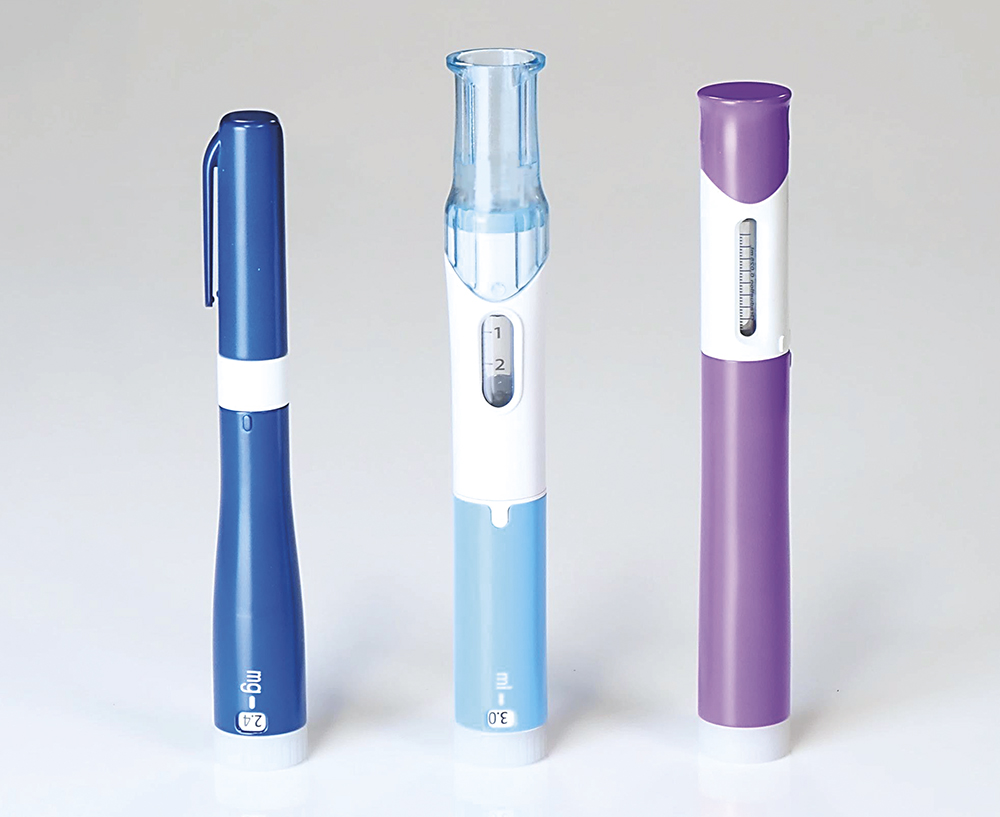
Figure 1: An overview of the Alcee injection platform – (left to right) multi-variable-dose pen injector, single-dose vial autoinjector and single-dose prefilled syringe (PFS) autoinjector.
Each injector type is a platform itself that can be used to deliver a variety of drugs based on the chosen primary container. Taking advantage of the commonality across Alcee injectors, pharmaceutical partners have the freedom to choose suitable handheld injectors to address different dosing needs with a more efficient timeline and lower development cost. Any dosing requirements beyond the pre-assumed specification range can be discussed case by case.
Alcee injectors comprise a reusable power unit and a disposable unit. The power unit provides the electromechanical drive and is rechargeable. The reusability of the Alcee power unit can reduce the cost per injection compared with disposing of the whole device after a single use. The disposable unit can easily be customised to accommodate the required injection volume. Any volumes larger than 3 mL up to 10 mL are possible but may translate to a longer delivery time. For larger delivery volume beyond 3 mL, it is recommended to use the Alby large-volume wearable injectors instead.1 All Alcee injectors offer the option of wireless connectivity for digital health management. An intuitive user interface with audible and visual feedback, and sharps protection features, are included as part of the standard models of Alcee.
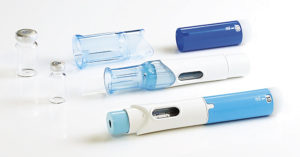
Figure 2: The designs of Alcee-V.
Single-Dose Vial Autoinjector
The Alcee vial autoinjector (Alcee-V) is a single-dose injector that uses a vial as the primary container (Figure 2). Among the three types of Alcee injectors, Alcee-V has the greatest flexibility in accepting the primary container (practically any vial shape and size having a crimp neck size between 13 and 20 mm). Although a total injection volume ranging from 0.5 mL to 10 mL is feasible, it is recommended to use the Alby large-volume wearable injector instead when the injection volume goes beyond 3 mL.1 Vials and Alcee-V devices are not housed together and may be shipped or packaged separately. Therefore, user loading of a vial to an Alcee-V device will be required prior to injection.
Single-Dose PFS Autoinjector
The Alcee PFS autoinjector (Alcee-PFS) is a single-dose injector that uses a PFS as the primary container (Figure 3).Standard Alcee-PFS models accept a 1 or 2.25 mL PFS. The housing of the Alcee-PFS can easily be customised to accept volumes other than 1 or 2.25 mL. The PFS filled with the drug is housed together with the disposable unit of Alcee-PFS; no user loading of the PFS is required.
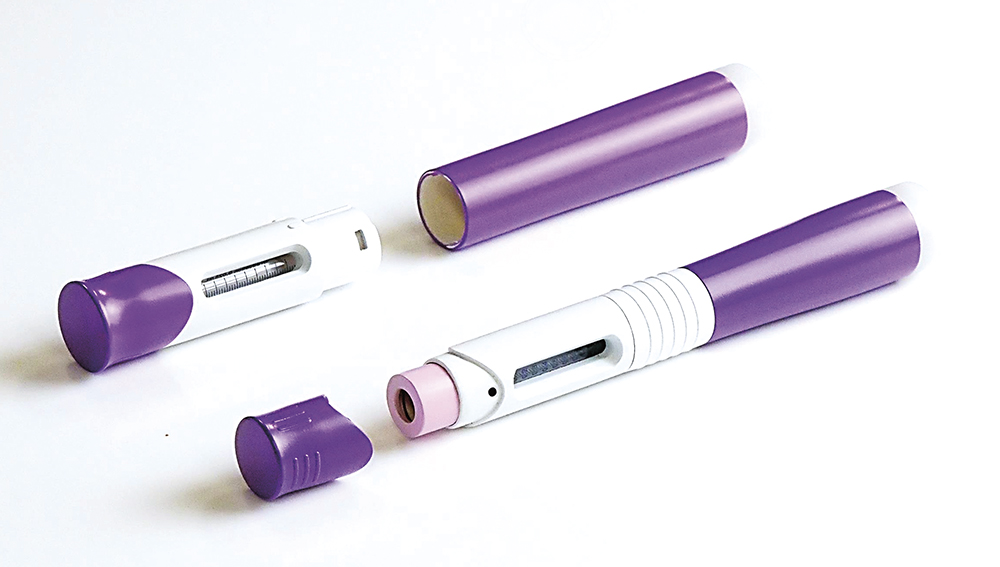
Figure 3: The designs of Alcee-PFS.
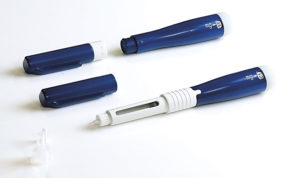
Figure 4: The designs of Alcee-P.
Multi-Variable-Dose Pen Injector
The Alcee pen injector (Alcee-P) is a multi-variable-dose injector that uses a cartridge as the primary container (Figure 4). Standard Alcee-P models accept a 3 mL cartridge, but the housing of the Alcee-P can easily be customised to accept cartridge sizes other than 3 mL. The Alcee-P dialling knob is fixed at the rear end of the device and does not extend or move linearly when turned. The dial options of Alcee-P can easily be customised by software for setting a variety of doses, and for certain functional selections such as priming (flow check) and Bluetooth connection. Each dose can range from less than 0.1 mL to a much larger quantity – in theory, up to the maximum injection volume. The precision of each dose can be less than 0.1 mL.
THE VERSATILITY OF ALCEE-V AUTOINJECTOR
Although vials are the most commonly used containers for packaging pharmaceuticals, they rarely appear in self-injection devices, in part due to the complexity of drug handling from a vial and the involvement of more device operational steps. To enable and facilitate the use of vials in self-injection devices, Alcee-V offers a solution with high versatility and automated device operation.
“The cap of Alcee-V serves as an adaptor that holds the vial and provides the interface for drug transfer from the vial to the injector.”
Versatility is the core competency of Alcee-V. The cap of Alcee-V serves as an adaptor that holds the vial and provides the interface for drug transfer from the vial to the injector. The Alcee-V cap can be highly flexible in shape and size to accept any vials (e.g. 2–20 mL) with a crimp neck size between 13 and 20 mm.
Alcee-V also provides an innovative solution that makes the preparation of a drug from a vial and the self-administration process simple, easy and safe. Since the vial filled with the drug and the Alcee-V device are not housed together, the user is able to access and clean the vial stopper prior to injection. After disinfecting the stopper, the user loads the vial into the cap of the Alcee-V. Aided by the automated function, the drug is automatically drawn from the vial into the body of the injector. Upon completing the drug transfer process, the user removes the cap along with the vial, and then performs injection just like a typical autoinjector. Besides the automated drug transfer, the injection process is also powered by the automated drive system. By avoiding manual operation of drug transfer and injection, the risks of user handling errors, dose inaccuracy caused by manual transfer, and sharps injury are greatly reduced.
“By avoiding manual operation of drug transfer and injection, the risks of user handling errors, dose inaccuracy caused by manual transfer, and sharps injury are greatly reduced.”
THE SUSTAINABILITY OF ALCEE INJECTION PLATFORM
Sustainability is increasingly important and relevant due to climate change. The growing demand for self-injection devices has continued to exacerbate the burden of medical waste. To reduce the environmental burden, the Alcee injectors are designed to have two distinctive device units with the goal of minimising the size and weight of the disposable unit relative to the reusable unit. Figure 5 illustrates how Alcee keeps the plastic parts of the disposable unit at a minimum while providing essential protection to the primary container and functional connection to other device parts.
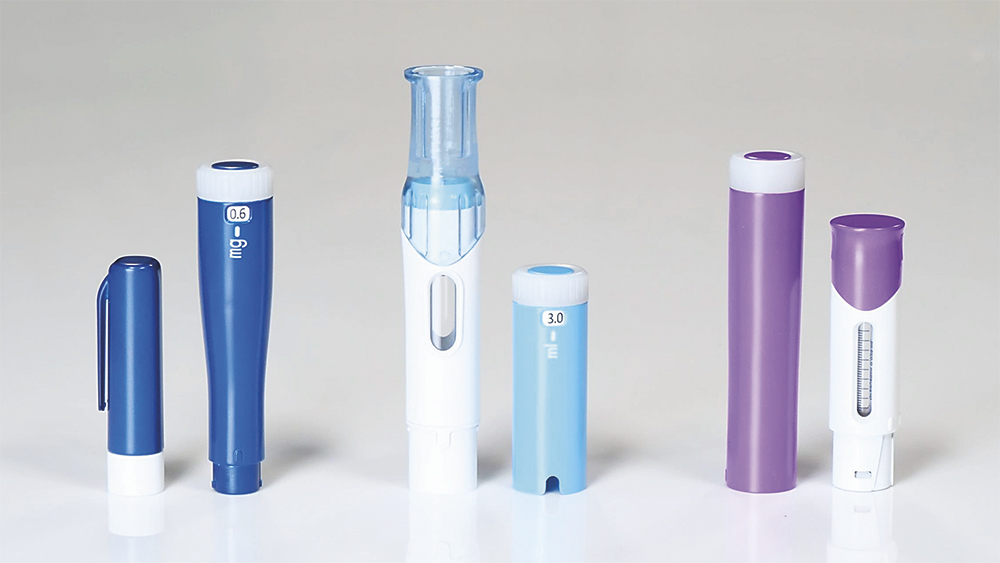
Figure 5: The reusable power units and the disposable units of the Alcee platform.
Eco-friendly materials are being considered for mass production of Alcee to further increase sustainability. For smart devices that contain electronics, reusability is critical to avoiding excessive generation of electronic waste after each use. Although sustainability is a focus of the Alcee design, other elements, such as functionality, usability and safety, have also been carefully considered and balanced in creating sustainable, robust products.
NEW OPPORTUNITIES WITH SMART DEVICES
Digital technology has already become an integral part of daily life, yet smart devices are at an early adoption phase in the self-injection space. Digitalisation of injectors offers huge potential in the enablement of telemedicine, the automation of device operation and the enhancement of patient compliance.
Smart devices are capable of generating, storing and sharing data to inform both users and healthcare professionals about the dosing. When a large amount of data is generated within a relatively short period of time, as in the case of multi-variable dosing or high-frequency injections, the monitoring and management of data become more relevant. Besides telemedicine, using a mobile app as an extension of the device user interface could offer users more support when it comes to device usage.
For example, the app could display animated step-by-step visual instructions to guide users on proper preparation and device operations. When the app is in sync with the visual or auditory feedback from the device, users could have access to a larger, more comprehensive interface via the phone screen to better capture the dosing status. To enhance patient compliance, the app could also send reminders to users when the next dose is due.
Although artificial intelligence (AI) has yet to be built into Alcee, the advancement of the electronics hardware for AI is now paving the way for future applications in many industrial sectors, including drug delivery. The question of how AI could apply to drug delivery is an interesting topic for future discussion.
“Alcee serves as a key enabler and differentiator for pharmaceutical products that require simple, fast and convenient self-administration.”
THE ENABLER AND PRODUCT DIFFERENTIATOR
Alcee serves as a key enabler and differentiator for pharmaceutical products that require simple, fast and convenient self-administration. By combining device versatility, sustainability and digitalisation, Alcee introduces a whole new opportunity to address a variety of dosing needs, including single-dose, multi-variable dose or doses with a customised profile through three different types of handheld injectors that support vials, PFSs and cartridges. Since all forms of Alcee are operated based on the same principle, developing one type of Alcee injector also accelerates the development of the other types of Alcee injector. Such synergies in development could translate into efficiency, thus saving development time, cost and effort compared with developing the injectors individually. The readiness of functional prototypes and the preliminary laboratory dose accuracy data suggest that Alcee is now ready to take further steps to conduct feasibility studies and development with potential drug candidates.
REFERENCE
- Chu L, “Enabling Large-Volume Subcutaneous Injection with a Smart Wearable Injection Platform”. ONdrugDelivery, Issue 164 (Sep 2024), pp 60–64.

